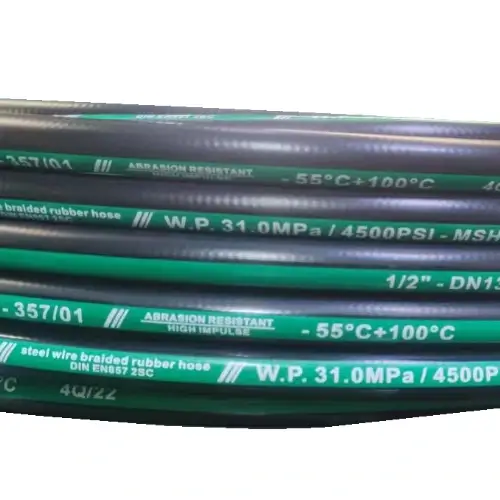335345435
Aug . 04, 2024 02:39 Back to list
Choosing the Right Low Temperature Hydraulic Hose for Optimal Performance in Harsh Conditions
Low Temperature Hydraulic Hose Essential for Extreme Environments
In various industrial applications, the functionality and reliability of hydraulic systems are paramount. One critical factor in ensuring optimal performance is the use of appropriate hydraulic hoses, especially when operating in low-temperature environments. Low-temperature hydraulic hoses are specifically designed to withstand harsh conditions, allowing hydraulic systems to function efficiently and safely even in extreme cold.
Understanding Low-Temperature Hydraulic Hoses
Low-temperature hydraulic hoses are constructed from specialized materials that maintain flexibility and integrity in environments where temperatures can drop significantly. Standard hydraulic hoses can become stiff and brittle in low temperatures, leading to potential failures and catastrophic leaks. To combat these issues, low-temperature hoses are typically made from synthetic rubber compounds or thermoplastic materials that remain pliable under cold conditions.
These hoses are often reinforced with high-strength fibers or steel braids to enhance their pressure resistance, while still maintaining performance in frigid temperatures. The design and manufacture of low-temperature hydraulic hoses adhere to rigorous industry standards to ensure they can operate effectively below the freezing point.
Applications in Various Industries
Low-temperature hydraulic hoses find applications across a broad spectrum of industries, including oil and gas, mining, agriculture, and transportation. In the oil and gas sector, for instance, these hoses are essential for hydraulic fracturing operations that occur in cold climate regions. They facilitate the transfer of fluids while ensuring that the mechanical properties of the hoses are preserved amidst icy conditions.
In mining, low-temperature hydraulic hoses are crucial for the functioning of various machinery, from excavators to drilling equipment. With temperatures often plunging below freezing in remote locations, the reliability of hydraulic systems can mean the difference between operational success and costly downtimes.
Agriculture also benefits from low-temperature hydraulic hoses, especially in northern climates where equipment must operate efficiently despite frost and snow. Tractors and other machinery equipped with low-temperature hoses can perform essential tasks more reliably, contributing to better crop management and yield.
low temperature hydraulic hose

Key Considerations for Selecting Low-Temperature Hoses
When selecting low-temperature hydraulic hoses, several factors should be considered
1. Temperature Range It’s crucial to identify the specific temperature range in which the hoses will operate. Different hoses are rated for different minimum temperatures, so selecting the right one is essential.
2. Pressure Rating Ensure that the hose can handle the pressure requirements of the hydraulic system. The hose must be compatible with the pressures involved in the application to avoid failure.
3. Fluid Compatibility Verify that the hose material is compatible with the hydraulic fluid it will be transporting. Some fluids can degrade certain hose materials, leading to early failure.
4. Length and Fittings The required length and type of fittings should match the hydraulic system setup. Proper fitting ensures a secure connection, preventing leaks.
5. Regulatory Standards Compliance with industry standards and regulations is vital for safety and efficiency. Always choose hoses that meet established guidelines.
Conclusion
Low-temperature hydraulic hoses are integral to the operation of hydraulic systems in environments where temperatures can drop significantly. By utilizing these specialized hoses, industries can enhance their operational efficiency and minimize the risks associated with hydraulic system failures. As technology advances, the materials and designs of low-temperature hoses will continue to improve, ensuring reliability and safety in even the most challenging conditions. In an ever-evolving industrial landscape, investing in quality low-temperature hydraulic hoses is not just a best practice; it's a necessity for success.
-
SAE 100 R17 Black Smooth Cover Hydraulic Hose
NewsMar.07,2025
-
SAE 100 R17 Black Smooth Cover Hydraulic Hose
NewsMar.07,2025
-
SAE 100 R17 Black Smooth Cover Hydraulic Hose
NewsMar.07,2025
-
SAE 100 R17 Black Smooth Cover Hydraulic Hose
NewsMar.07,2025
-
SAE 100 R17 Black Smooth Cover Hydraulic Hose
NewsMar.07,2025
-
steel wire braided hydraulic hose
NewsMar.07,2025



